Introduction
This tutorial is for English teachers and students to address a fundamental skill in language learning: vocabulary.
After all, that’s what dictionaries are for.
Wordnetplus is an encyclopedic dictionary that helps build english vocabulary skills and, at the same time, be a powerful instrument of knowledge acquisition, with its unique features bundled to ease the mental process of memorizing new words.
Next, we demonstrate Lexsemantic / WordnetPlus basic features, and how to use them in language teaching and learning.
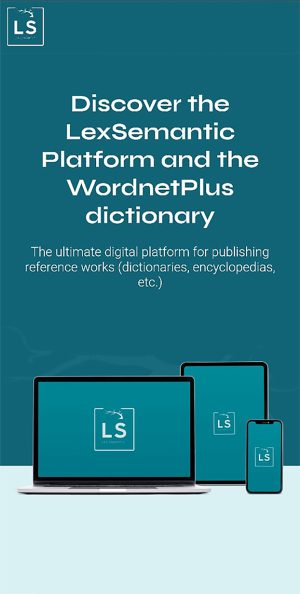
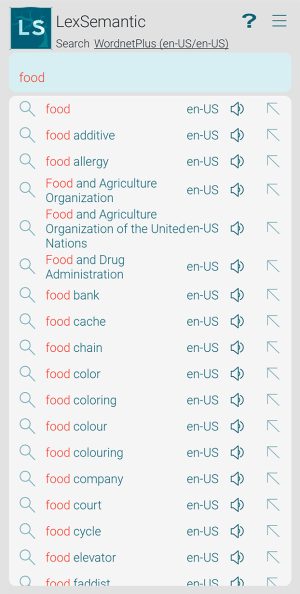
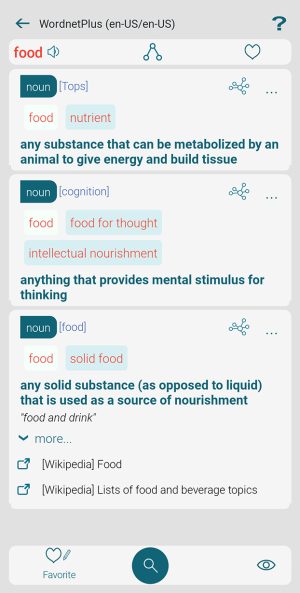
Lists
The LexSemantic Platform allows you to build Lists of Entries and synchronize with other user’s devices.
In this way, the teacher can create custom lists and distribute (exporting) them to their students, so that they can use them (importing) in their studies and exercises.
Some examples:
- Understand a certain text
- Situations (travel, restaurants, shopping)
- Places
- Plants
- Architecture
To learn more about this feature, visit the Lexsemantic website, Use Case – List .
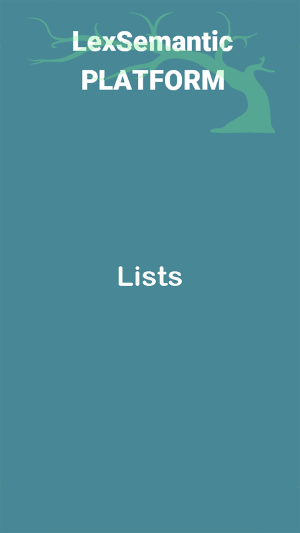

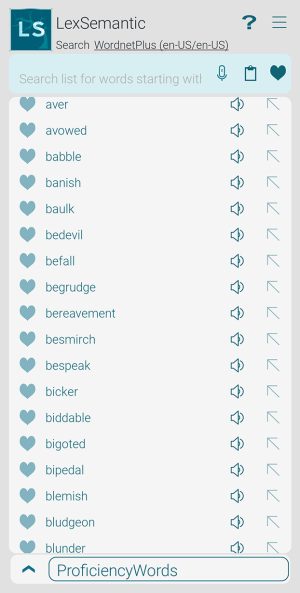
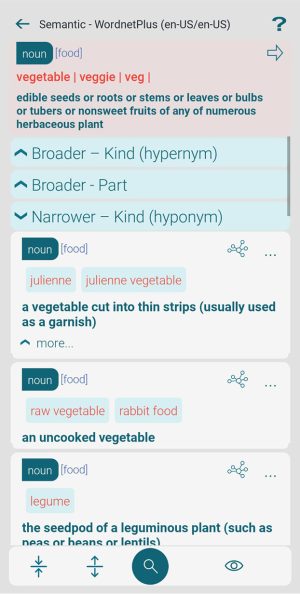
Entry Organization
Regular dictionaries organize entries by placing their polysemic definitions (different concepts) under the same grammatical category. In WordnetPlus, each conceptual definition has its own, as it is associated with other functionalities, for instance, grammatical category, as described below.
Definition and Examples
The definitions are concise and objective, allowing the student to immediately understand the conceptual meaning of the entry.
In addition, for nouns and verbs, the subject to which the definition refers (for example, cognition, act, food, plant, etc.) is provided, which helps to understand its context.
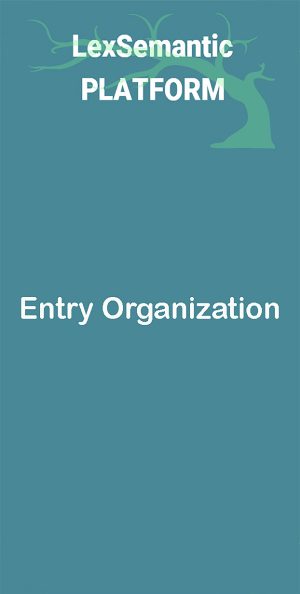
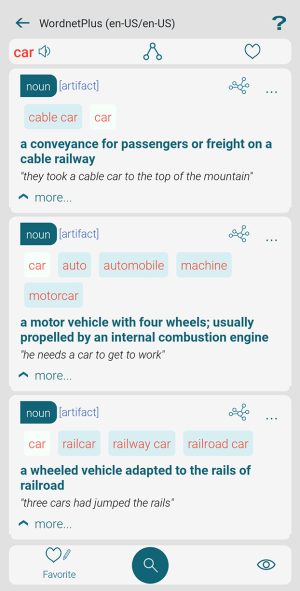
Synonyms (synset)
An extremely significant point that sets WordnetPlus apart from common dictionaries is synset, that is, synonyms that share the same concept and can therefore be used interchangeably in a sentence with little or no conceptual difference.
Therefore, it helps the student understand the meaning of a word and enrich their vocabulary with perfect synonyms.
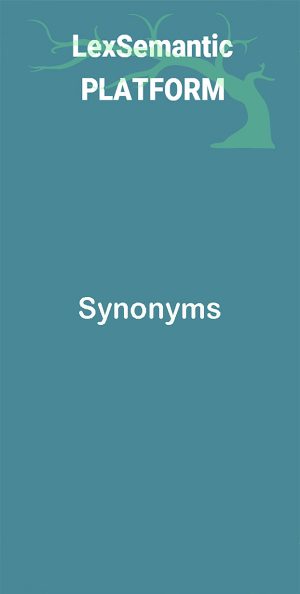
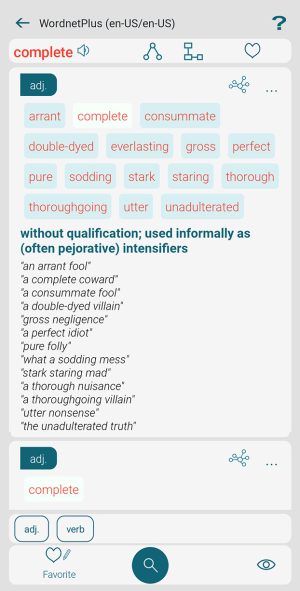
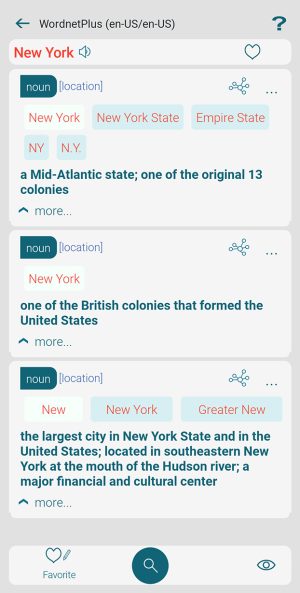

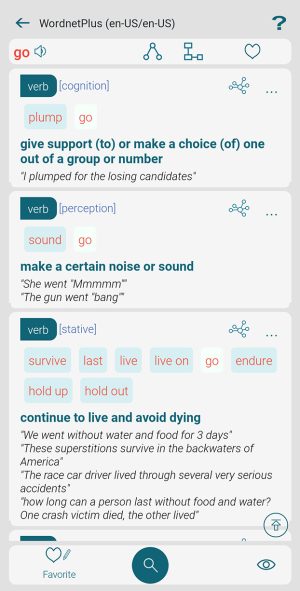
Prefixes & Suffixes
The English language has a significant number of prefixes that are used to form new words and modify the meaning of existing words. English has borrowed prefixes from various sources, including Latin, Greek, French, and Germanic languages.
By understanding and utilizing prefixes, students can enrich their language skills, improve their vocabulary, and communicate with greater precision. Prefixes offer a valuable tool for modifying and expanding the meanings of words, contributing to effective expression in the English language.
Suffixes play an essential role in the English language by adding meaning and grammatical function to base words. They provide versatility and flexibility in word formation, grammatical structure, and conveying specific meanings. Understanding and using suffixes correctly can greatly enhance one’s command of the English language.
In this way, the teacher’s encouragement to study prefixes and suffixes is a fundamental item in language teaching, for the rapid enrichment of their students’ vocabulary.
The Princeton Wordnet – PWN does not contain prefixes and suffixes, however, WordnetPlus not only includes them, but also establishes a semantic relationship between them and the concepts in which they apply, making it unique and the most complete dictionary in this category.
Prefixes
Obtaining the word prefix, in its semantic relationship, Narrow-Member, all prefixes and their meanings and examples are listed.
In each of them, it is possible to obtain the semantic relationship, Broader-Word Formation, with the entries that contextualize them.
For example:
- acro- -> peak, crest…
- agro- -> agribusiness…
- caco- -> bad or defective
- from the entry, bad -> caco-; mis- (semantic relationship Narrower- Word Formation)
- angio -> blood
- from the entry, blood -> – aemia (suffix); hem-, histi- (semantic relationship Narrower- Word Formation
Suffixes
Obtaining the word suffix, in its semantic relationship, Narrow-Member, all suffixes and their meanings and examples are listed.
In each of them, it is possible to obtain the semantic relationship, Broader-Word Formation, with the entries that contextualize them.
For example:
- -ability -> suitability
- -emia, -aemia -> blood
In this way, the student can obtain their prefixes (bad -> caco-) or their suffixes (blood -> -aemia) from a certain entry.
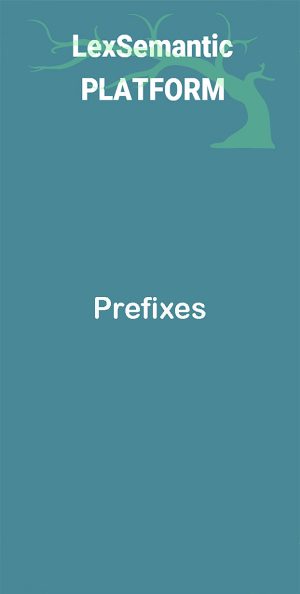

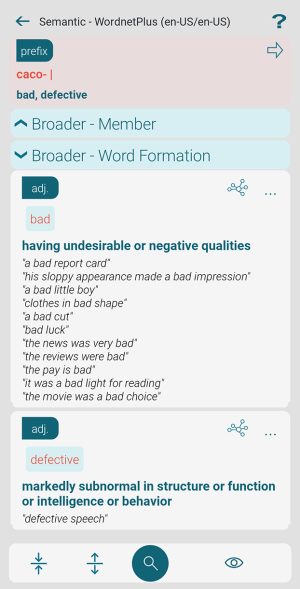
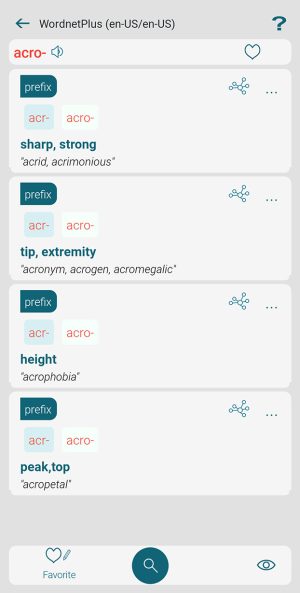
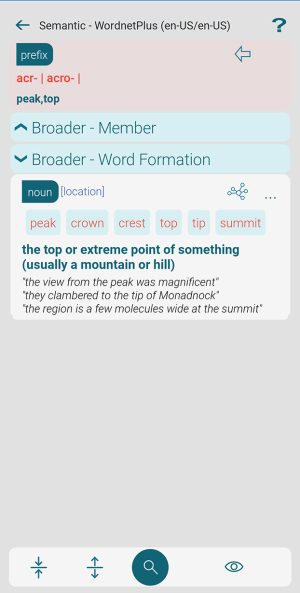

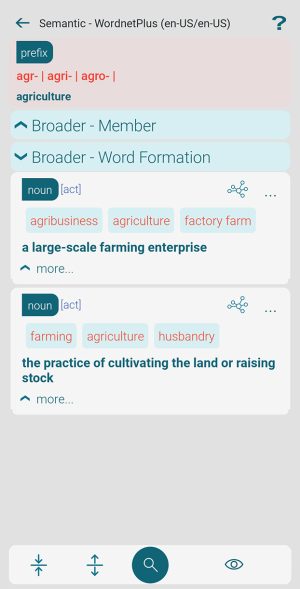
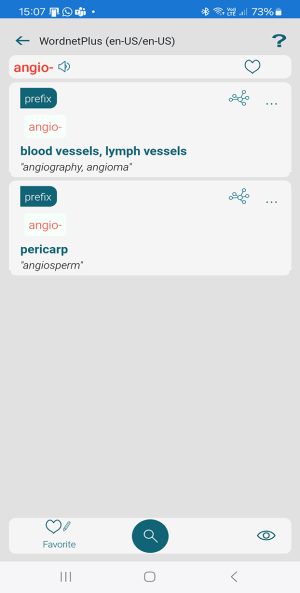
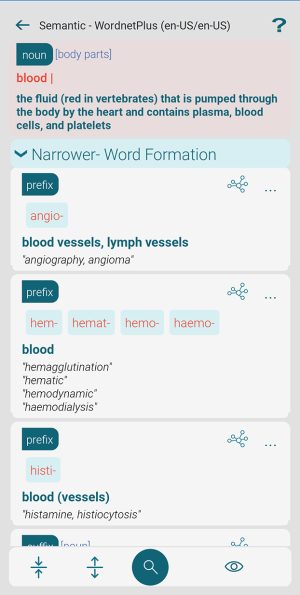
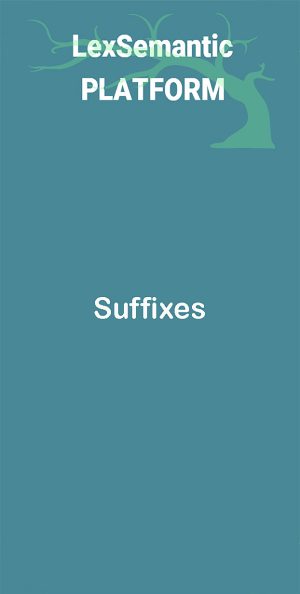
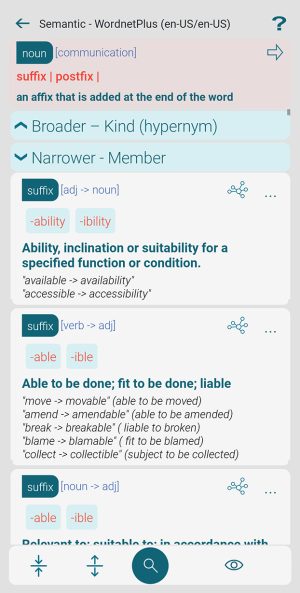
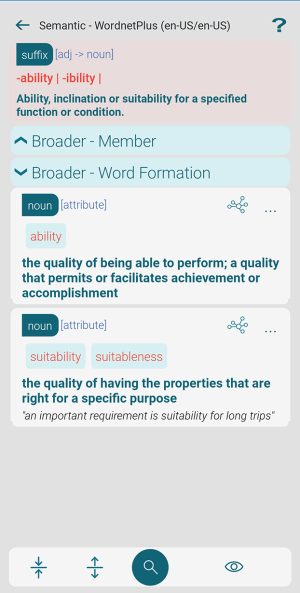
Definitions (facilities and translation)
For those who teach English as a foreign language, some WordnetPlus features support the understanding of definitions and examples of entries. Here are some of them.
- Simple and objective definitions of concepts and illustrative examples.
- Immediate access to the words that make up these definitions and examples, including the identification of compound words.
- Synonyms that share the concept, making it easier to infer the meaning of each of them.
- For nouns and verbs, it informs the subject to better identify what the concept of each definition refers to.
- Some semantic relationships lead to other similar concepts, which even contributes greatly to vocabulary enrichment.
- Integration with Wikipedia for extensive encyclopedic explanation of nouns.
- Translation into the student’s native language.
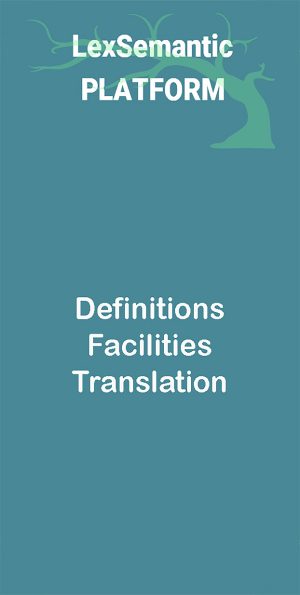
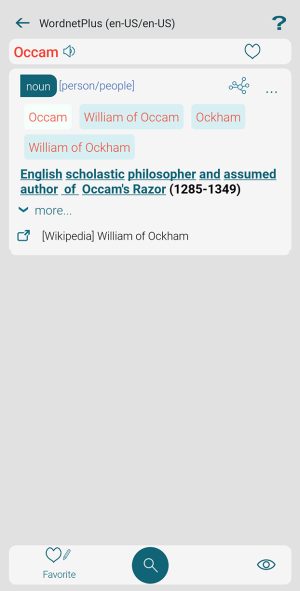
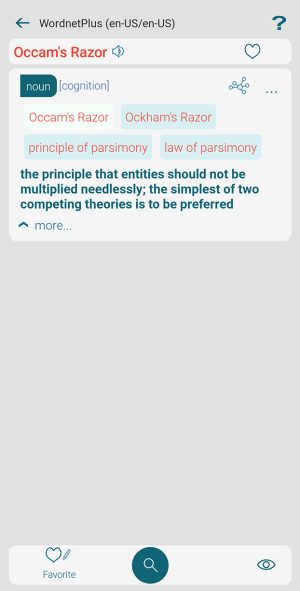
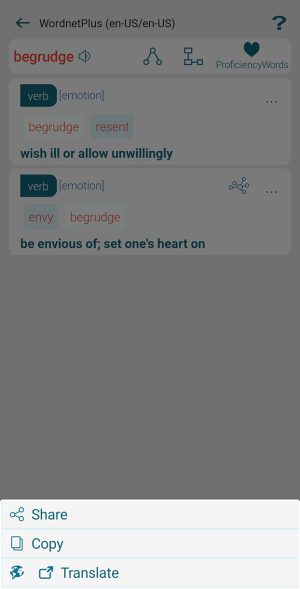
Lexical Relationships
These are relationships between distinct concepts of a given entry in different contexts. They support not only the understanding of the entry, but are important for enriching the student’s vocabulary.
They are as follows:
- Direct antonyms [painful is an antonym for painless]
- Indirect antonyms (adjectives that have similarity to each other) [comfortable is an indirect antonym for painful]
- Phrasal verbs [sleep forms sleep in, sleep out, sleep late]
- Pertaynym [academia is pertinent to academic]
- Derivation related (same root) [academic is related to academy]
In addition, it presents the morphological derivations of the entry (gender, number, degree and verbal conjugations).



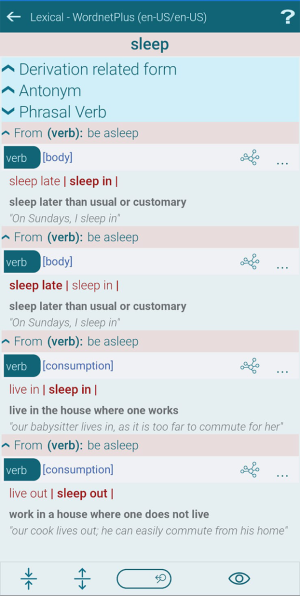
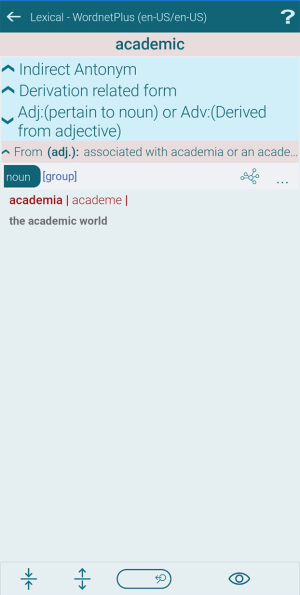
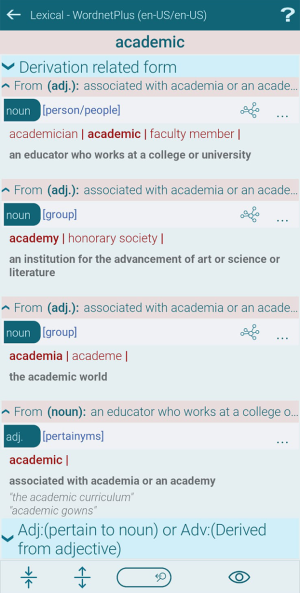
Semantic Relationships
These are relationships between concepts semantically interconnected by generalization or specialization.
For example, a tree is a specialization (member) of the forest; while the forest is a generalization of the tree.
There are several forms of semantic relationships (broader <-> narrower), namely:
- kind [canine <-> dog]
- Instance [historic period <-> renaissance]
- Member [forest <-> tree]
- Substance [air <-> nitrogen]
- Part [car <-> air bag]
- Attribute [weight <-> heavy]
- Domain [botany <-> plant]
- Entailment (verbs) [force <-> press]
- Cause (verbs) [force <-> move]
- Verb group [force <-> drive]
- See also (adj) [abstract <-> intangible]
- Similar to (adj) [nascent <-> emergent]



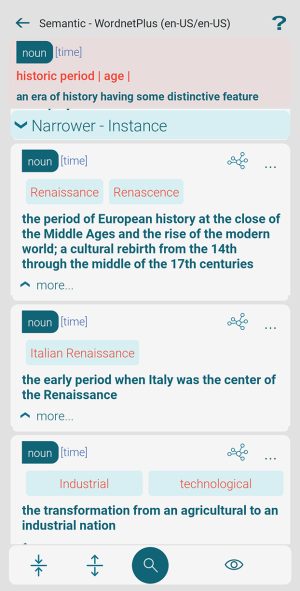
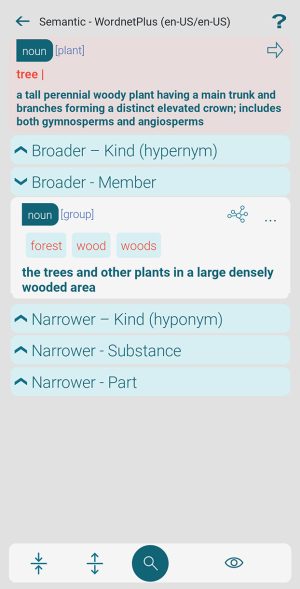
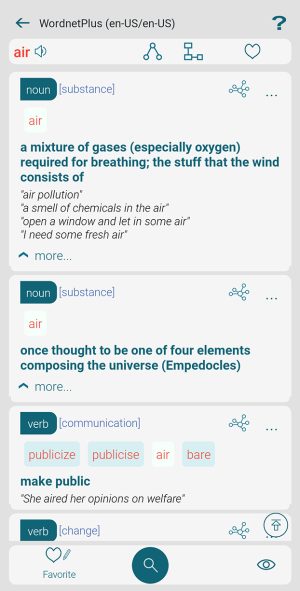
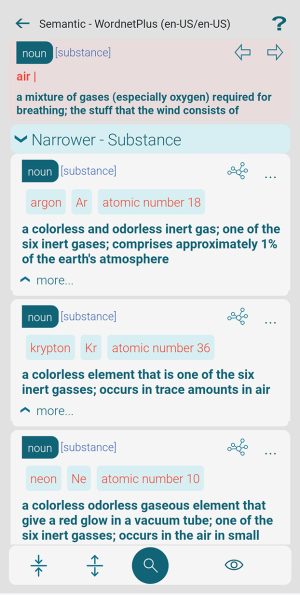

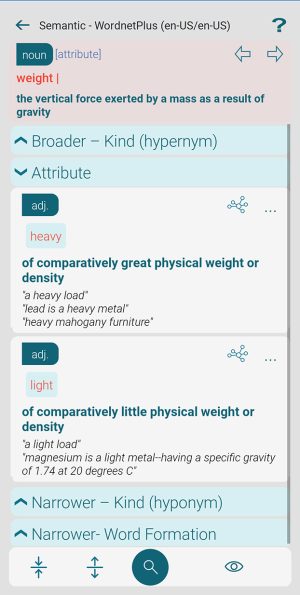
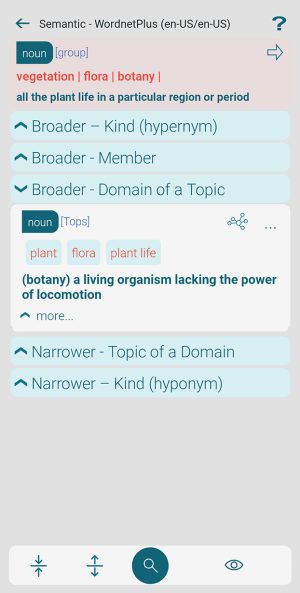
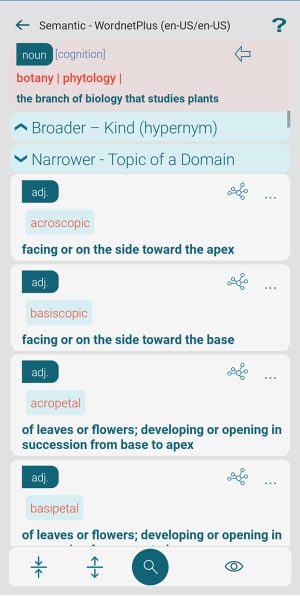
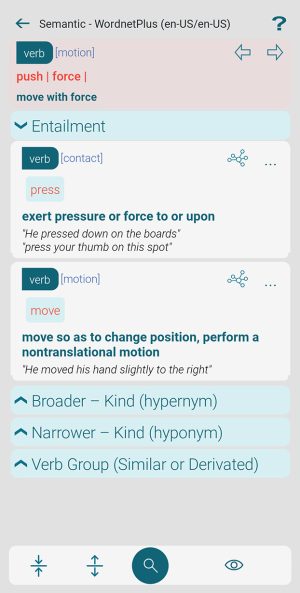

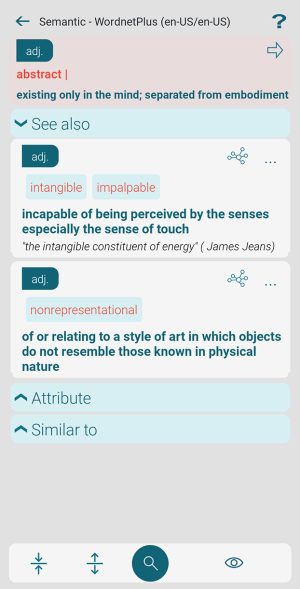

Using Semantic Relations
The presentation of Semantic Relations by the teacher to students is a tool to expand their linguistic abilities.
For example:
- From the concept of the verb transport as “move something or somebody around” one learns the specialized concepts of sluice, float, ferry, bus etc.
- By deepening the concept of float, one has tide, drift, refloat.
- Idem for vegetable as a food, one obtains julienne, rabbit food, legume, potherb etc.
- From legume one has its varied types such as pulse, bean, lentil etc.
- and the substance protein indicating an important contribution of legume to human beings.
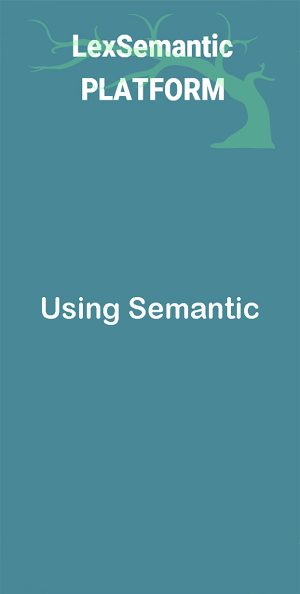
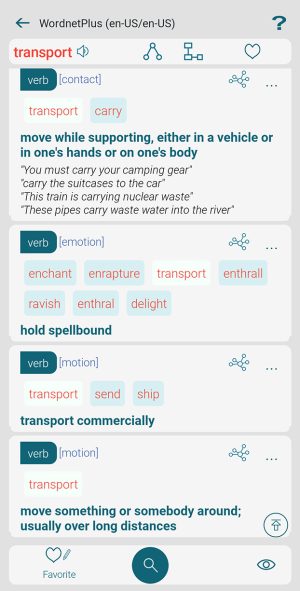
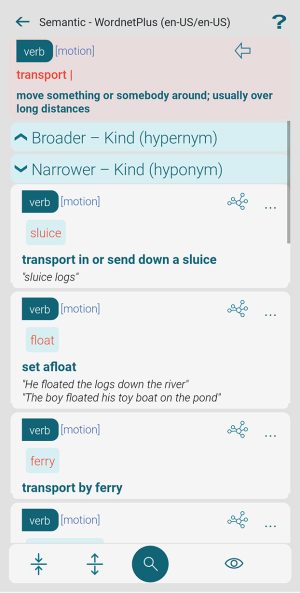
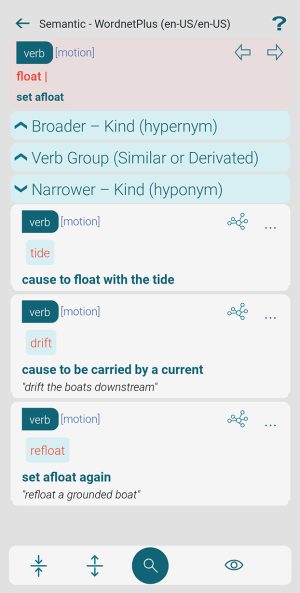
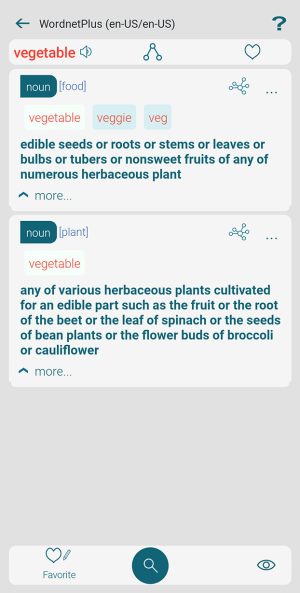
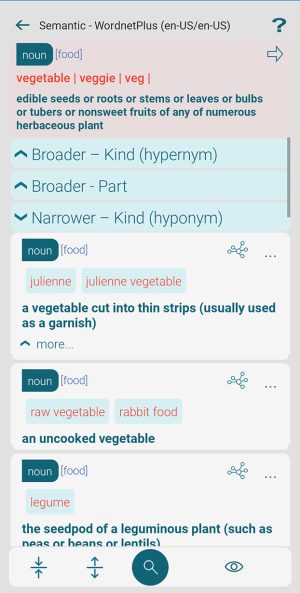
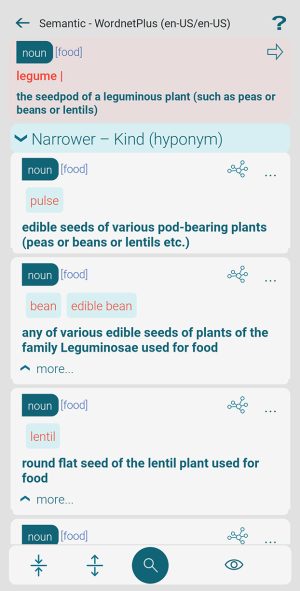
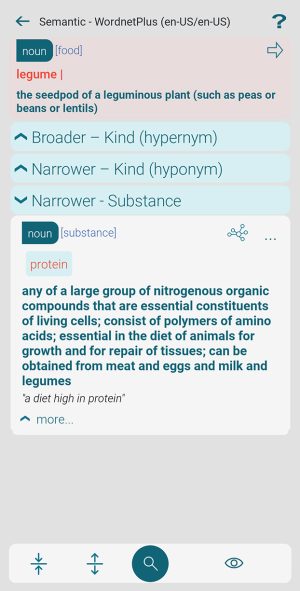
Knowledge Acquisition with Semantic Relations
The association of language learning with knowledge acquisition represents an important motivation for the student and a strong tool for memorizing entries.
As WordnetPlus is also encyclopedic, its semantic relations serve to explore certain themes of universal knowledge.
Examples:
- Study of rocks in the subject substance (aggregate of minerals that form the earth’s crust):
- One obtains the main types of rocks, such as sedimentary rock which has types: argillite, arenaceous rock etc.
- Analysis of a country, such as Brazil:
- In Instance or in Part, indicate that it is in South America
- In Member, that it is part of the OAS
- In Part (Narrow), one has its main cities, rivers etc.
- A Science like Biology
- In Domain, the adjectives that reference it
- In Kind, its ramifications such as biogeography, phytology, cryobiology etc.
There are thousands of possibilities in which the teacher can exercise his students by expanding their vocabulary and culture at the same time.
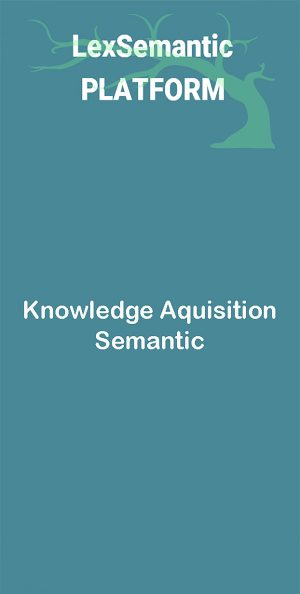
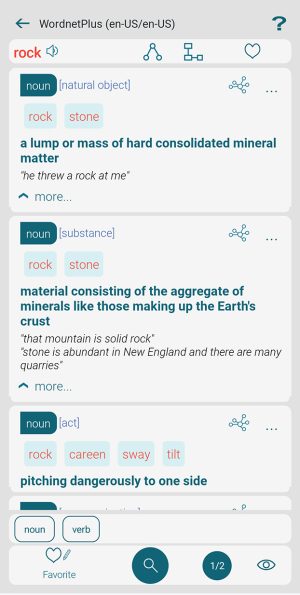
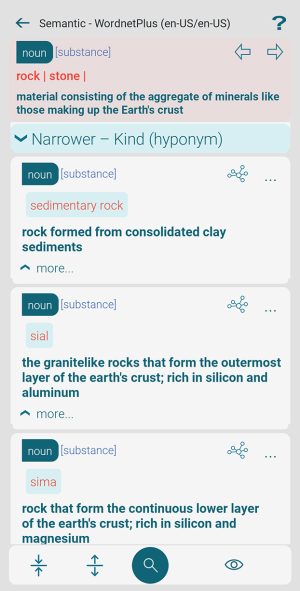
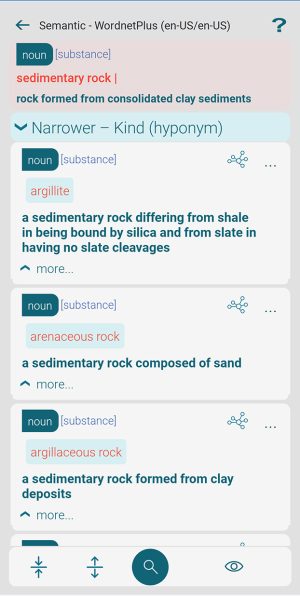
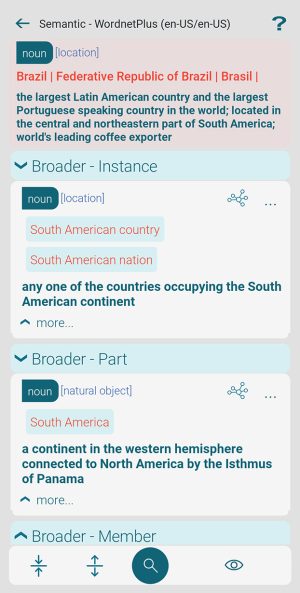
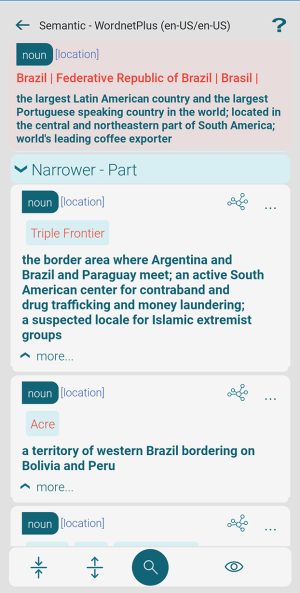
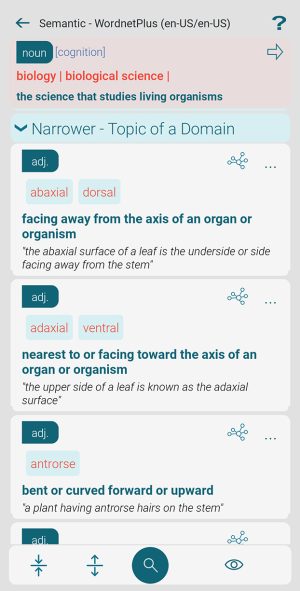
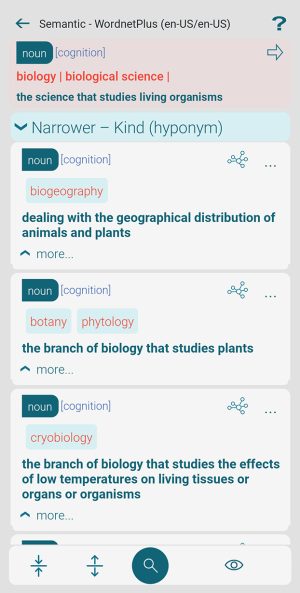
Wikipedia Integration
About 50,000 nouns from WordnetPlus were manually integrated (disambiguated) with Wikipedia.
This, combined with Semantic Relations, means an expansion of the possibility of knowledge acquisition by students deepening their studies on the themes addressed in WordnetPlus, that is, a taxonomic index to Wikipedia.
The examples mentioned earlier, follow with the exposure of Wikipedia as a frame of WordnetPlus.
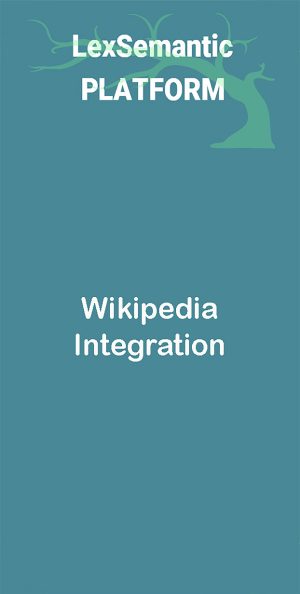
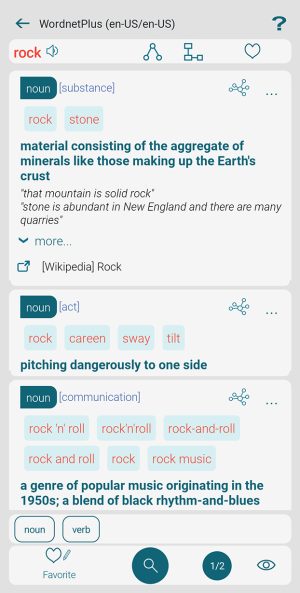
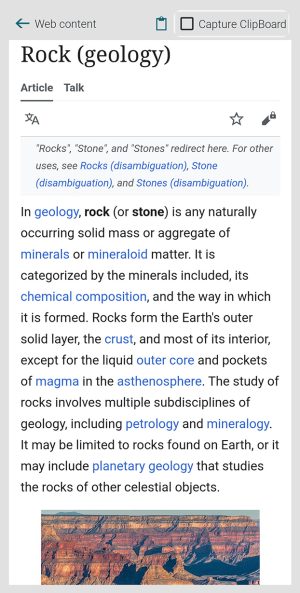
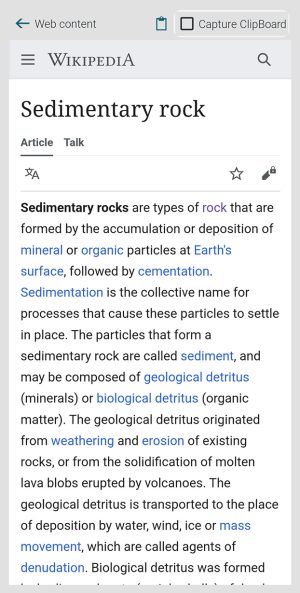

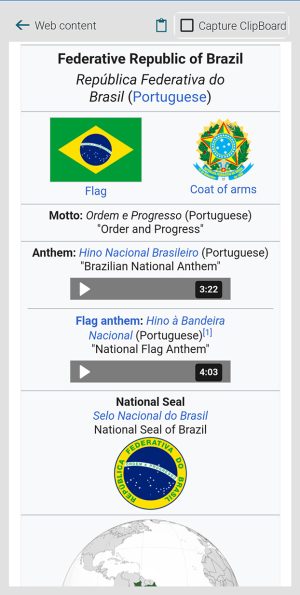
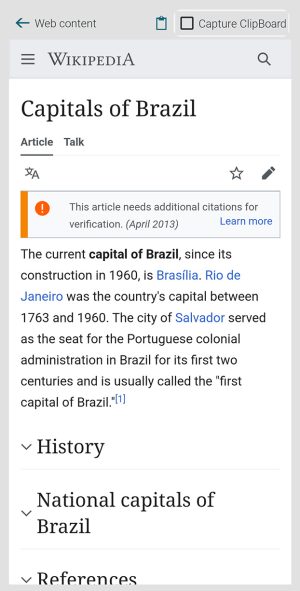


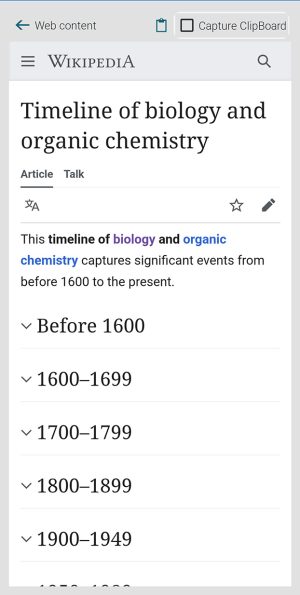
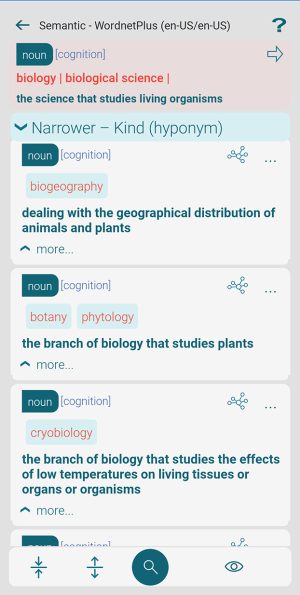
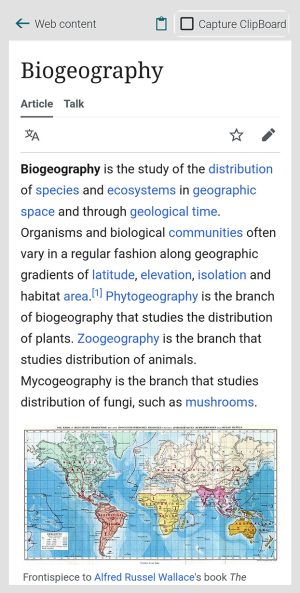
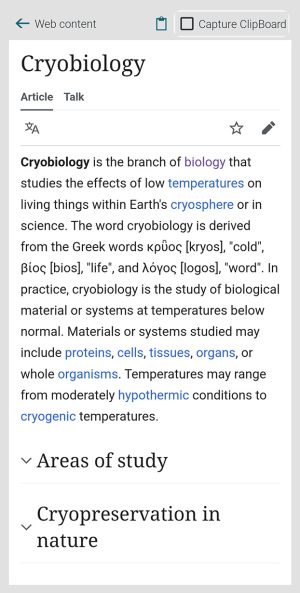
Expanding the Concept of a Word
We will give some examples of how using the semantic relations to enrich the vocabulary from the concept represented by a word.
ability
1) There are two concepts related to the word “ability”:
- Possession of the qualities required to do something or get something done.
- The quality of being able to perform.
2) Narrower–Kind leads to words that represent possession of qualities, such as: know-how; leadership; intelligence; aptitude, etc.
3) Narrower–Kind leads to words that represent the ability to perform, such as: adaptability; sensitivity; competence; form, magical power, etc.
4) Additionally, the semantic relationship Narrower-Word Formation leads to suffixes that represent the ability to perform, such as: -ability; -craft; -ship.
5) Using Wikipedia integration to expand the concept of “know-how”.
cry
6) Noun in the concept of “loud utterance”: bellow; blue murder; catcall; cry, etc.
7) Noun in the concept of “utterance of an animal”: baa (sheep); bark(dog); bray (ass), etc.
8) Verb in the concept of “shed tears because of sadness”: wail; bawl; loom; under; snivel.
defend
9) In the concept of “a person who cares for persons or property”: reminder; bodyguard | escort; paladin; chaperon; fireman, etc.
grunt
10) In the Broader–Kind semantic relationship, we see that this is a family of fish whose name is associated with the characteristic of teeth grinding.
In the relation Narrower–Member we have its species such as: margate; Spanish grunts, etc.
11) Grunt fish family on Wikipedia.
Imaging | tomography
12) In the area of medicine, it represents the instruments for obtaining images of the inside of the body and their integration with Wikipedia in two encyclopedic entries: Tomography and Imaging.
13) The various types of tomography, such as: X-raying; snography; Magnetic Resonance Imaging, etc.
Many other concepts can be broken down into their specializations in WordnetPlus, making it a valuable tool for acquiring and enriching students’ vocabularies and, even more, with the perspective of increasing their knowledge using Wikipedia as a tool.
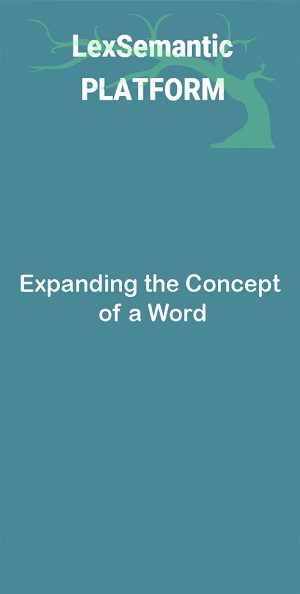
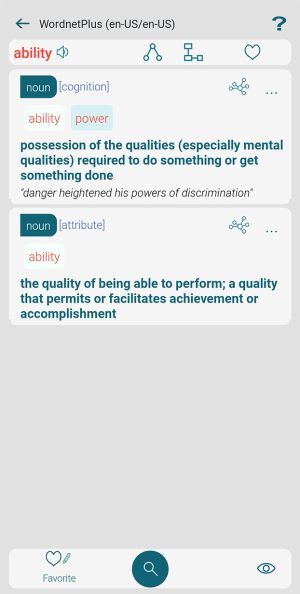
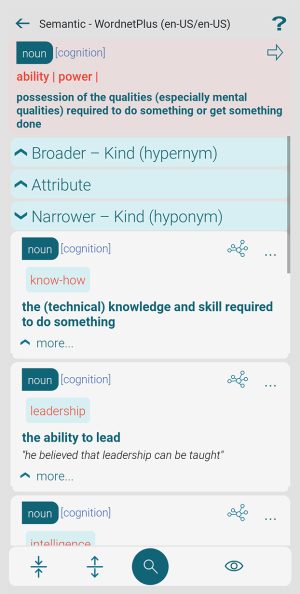
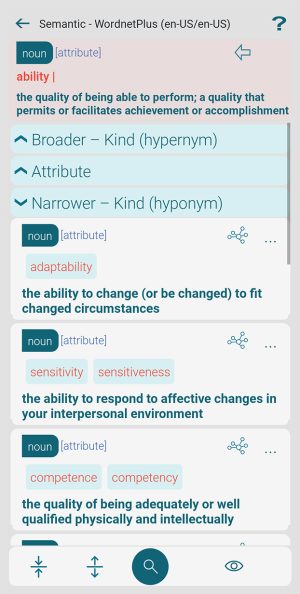
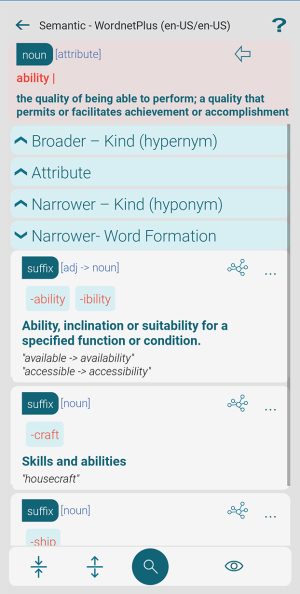

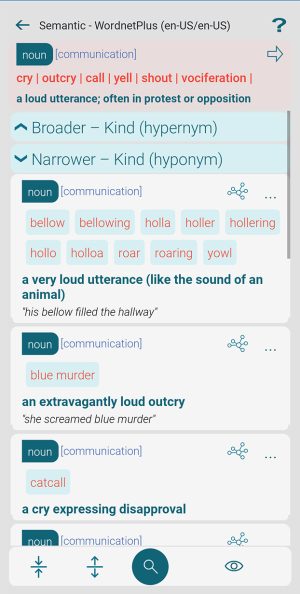
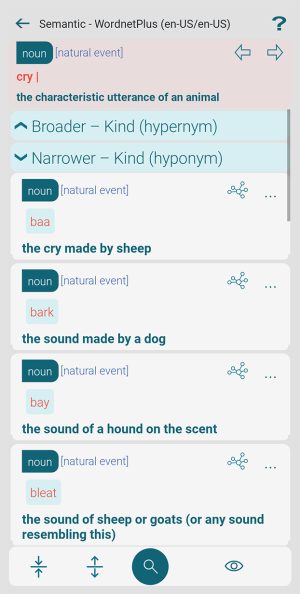
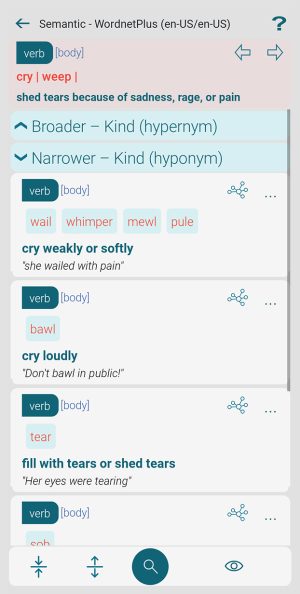
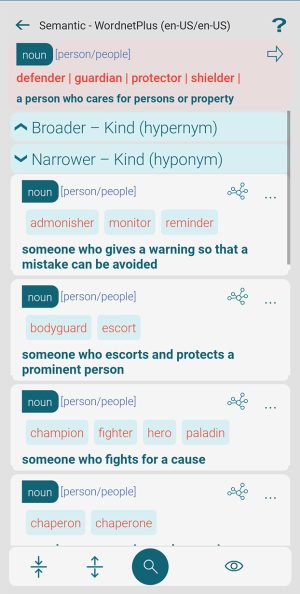
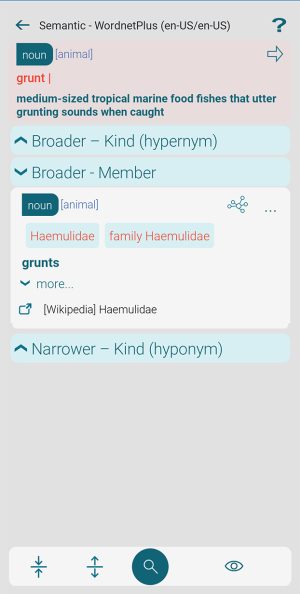
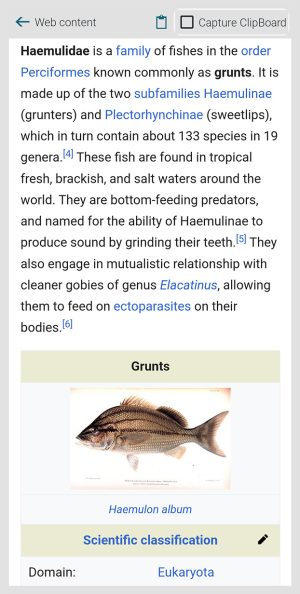
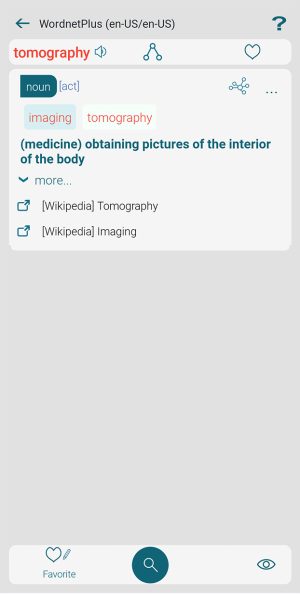

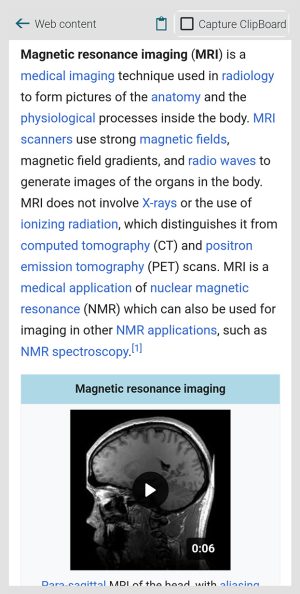
Enriching Vocabulary
We have shown above only the tip of the iceberg of the possibilities of WordnetPlus for teachers and their students to use the WordnetPlus dictionary, not only to discover the meaning of difficult words, but as a playful and permanent tool for enriching their vocabulary and knowledge, whose functionalities are unique and not found in regular dictionaries.
We remind you that LexSemantic is mainly a platform for launching reference works (dictionaries, encyclopedias, etc.) by authors who wish to share their knowledge with the public.
